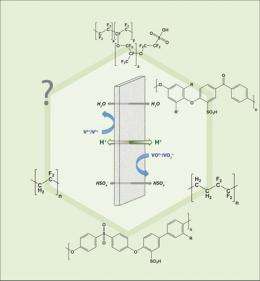Scientists enumerate advances, retreats in designing new membranes for renewable energy storage

(PhysOrg.com) -- Making wind and solar energy reliable parts of the nation's power grid means storing energy when it is created and discharging it when needed. Vanadium redox flow batteries could be the storage solution. However, an internal membrane's cost and performance has hampered widespread use. Currently, the thin Nafion membrane is responsible for 11% of the entire battery's cost. Research on replacing or refining this membrane was examined by Dr. Birgit Schwenzer and her peers at Pacific Northwest National Laboratory. Their review appears in a special edition of ChemSusChem, a top 20 multidisciplinary chemistry journal.
Since the vanadium redox flow battery was first invented, researchers have studied refining the Nafion membrane, a DuPont polymer containing sulfur and fluoride, or replacing the Nafion with a less-expensive option. In their paper, Schwenzer and her colleagues discuss the required features of an efficient membrane, including chemical stability, water transport, and ion diffusion.
"Reviewing the membrane research, which began in the mid-1980s, is an important and ambitious undertaking," said Dr. Jun Liu, who leads the Transformational Materials Science Initiative at PNNL and is a colleague of Schwenzer's. "I'm delighted with the depth and breadth of this article."
Finding or designing an efficient membrane demands a more inclusive approach than is typically taken, notes Schwenzer. Replacements or refinements to the membranes must be examined on their own and in working batteries.
"A lot of studies provide data on the membranes ex situ, outside of the battery," said Schwenzer, an inorganic chemist. "But, there are no follow-up articles showing how the materials perform inside a battery. The studies say that some properties of the membranes are good, but they don't show you the actual battery data."
The nation relies on fossil fuels to meet its residential and industrial energy demand, with coal providing about half of the electricity consumed in the United States. The emissions from coal and other fossil fuel plants cause environmental concerns. However, replacing these power sources with wind and solar farms requires megawatt-level storage capacity to buffer the intermittent generation from these renewable sources. Vanadium redox flow batteries could fit the bill, if membrane cost and maintenance issues are resolved.
"I'm hoping that our article in ChemSusChem is a guide for researchers to see what worked and what didn't," said Schwenzer. "It could help them design the materials they need to build better batteries, showing them where the opportunities lie and where current challenges exist."
The authors of this review are part of a team of materials experts at PNNL who are putting this information to use by conducting fundamental and applied research to reduce the costs and improve the efficiency of large-scale energy storage. Currently, Schwenzer and her colleagues are building larger batteries to see how changes to the membrane and other battery components affect the overall performance.
"We are looking at the whole system and determining why it fails -- not just if it fails," said Schwenzer.
More information: B Schwenzer, J Zhang, S Kim, L Li, J Liu, and Z Yang. 2011. "Membrane Development for Vanadium Redox Flow Batteries." ChemSusChem 4(10)1388-1406. DOI: 10.1002/cssc.201100068
Provided by Pacific Northwest National Laboratory

















